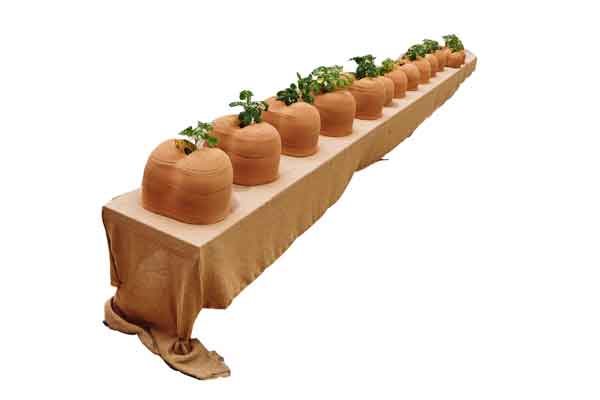This is how we can describe one and two hundred varieties of potatoes. This seed, which is seed and food at the same time, is one of the oldest goods that humans, by imitating animals, learn how to pick, cultivate and eat. For centuries these tubercles nurtured and shaped the constituency of communities living across the vast and high andean region, all the way down to the low maritime shores in the Caribbean sea. Rich in minerals and energy, the potato crossed the Atlantic to sprout in the lands of those who claimed its own, and expanded throughout the earth's soil to be unearthed from the underground like fish from the underwater.
In the studio I have a colorful poster that depicts one hundred eighty one kinds of tropical fish, and now that I’m writing next to it, about potatoes, I can’t stop seeing them as heterogeneous, stone-like, round and colorful potatoes. At first impression you wouldn’t think that fish and potatoes have much in common, but the more I stare at the fish in the poster, out of the water, the more I taste potatoes in my mouth.
I am wondering, with poetic license, would it be fair to call potatoes the fish of the underground?
The history of potatoes and their world expansion meets the history of agriculture, land engineering and global trade to the present, and even to the imaginaries and projections of human survival in outer space. Fish, as water living organisms, are also an intriguing and rich source of knowledge and sentience in the light of the same issues, from the fact of carrying with them inanimate and living ancestral DNA, to, in many cases, become species with human-made waste materials.
Like potatoes sunken in the ground, fish are not ruled by horizontal or coordinated movement (up, down, left right), they rather experience volumetric motion underwater. You might think this is a questionable affirmation, but think about it. When you leave your potatoes in the forgotten corner of your pantry, stalks like roots start growing in every direction. If you put them on soil, the stems of the plant look for the light and grow vertically, against gravity, while the seeds, which are the tubers, are a rhizome exploding quietly underground. When purple flowers open on top, the potatoes are ready to fish out.
There are more than four thousand varieties of potatoes existing. Many would say that our habits have reduced them to a few hundreds and counting, like fish; but a good friend, who grew up in one of the high plateaus where the papas are from, told me that once a wise woman told him that not animals nor potatoes become extinct, they just hide in other worlds and wait for the right time to sprout back.
Are ancient fish coming back to the surface, where they left an ocean before, in the fossil-shape of potatoes?
Each of these potatoes is the sea
A coral reef
A huge rock
The earth
A constellation
A meteorite
The milky starch way
Shooting stars pass them by
Beams of light
Clouds
The moon
They are walking heads
Together they are underground woods
Fungi webs
Grazing sites
Rocky mountains
Planets
Each one different from the other
In each one, the whole universe.




